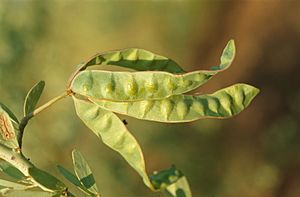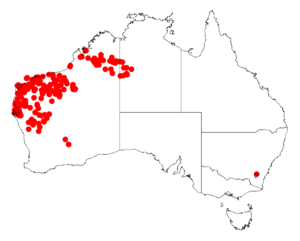Bardi bush facts for kids
Quick facts for kids Bardi bush |
|
|---|---|
 |
|
| Scientific classification | |
| Genus: |
Acacia
|
| Species: |
synchronicia
|
 |
|
| Occurrence data from AVH | |
Acacia synchronicia, often called bardi bush, is a type of shrub or tree. It belongs to the Acacia family, which is a large group of plants found mainly in Australia. This plant is native to Australia.
Contents
What the Bardi Bush Looks Like
The bardi bush is a spreading shrub or tree that often has thorns. It usually grows to be about 1.5 to 4 meters (5 to 13 feet) tall. Sometimes, it can even reach up to 6 meters (20 feet) high!
It often has many main stems growing from its base. The bark near the bottom of the main stems is grey and has long cracks. Higher up on the branches, the bark is smoother. It can be different colors like bronze, yellowish-orange, or green.
The bardi bush blooms with bright yellow flowers. You can see these flowers from August to December.
How the Bardi Bush Got its Name
The bardi bush was first officially described by a botanist named Bruce Maslin in 1992. He wrote about it in a science journal called Nuytsia.
Later, in 2003, another botanist named Leslie Pedley changed its name to Racosperma synchronicium. However, in 2007, it was changed back to its original name, Acacia synchronicia.
Where the Bardi Bush Grows
You can find the bardi bush scattered across several regions in Western Australia. These areas include the Kimberley, Pilbara, Mid West, and Goldfields-Esperance regions. It also grows in the western parts of the Northern Territory.
This plant often grows in specific places. You might find it on flat areas near rivers (called alluvial flats) or in low, hollow places (depressions). It also likes stony plains and areas along watercourses. The bardi bush grows well in rocky sand, clay, or loam soils. It is often found near areas with limestone or quartz rocks.
Images for kids




